fuses FORD E-450 2004 Owners Manual
[x] Cancel search | Manufacturer: FORD, Model Year: 2004, Model line: E-450, Model: FORD E-450 2004Pages: 240, PDF Size: 3.8 MB
Page 2 of 240
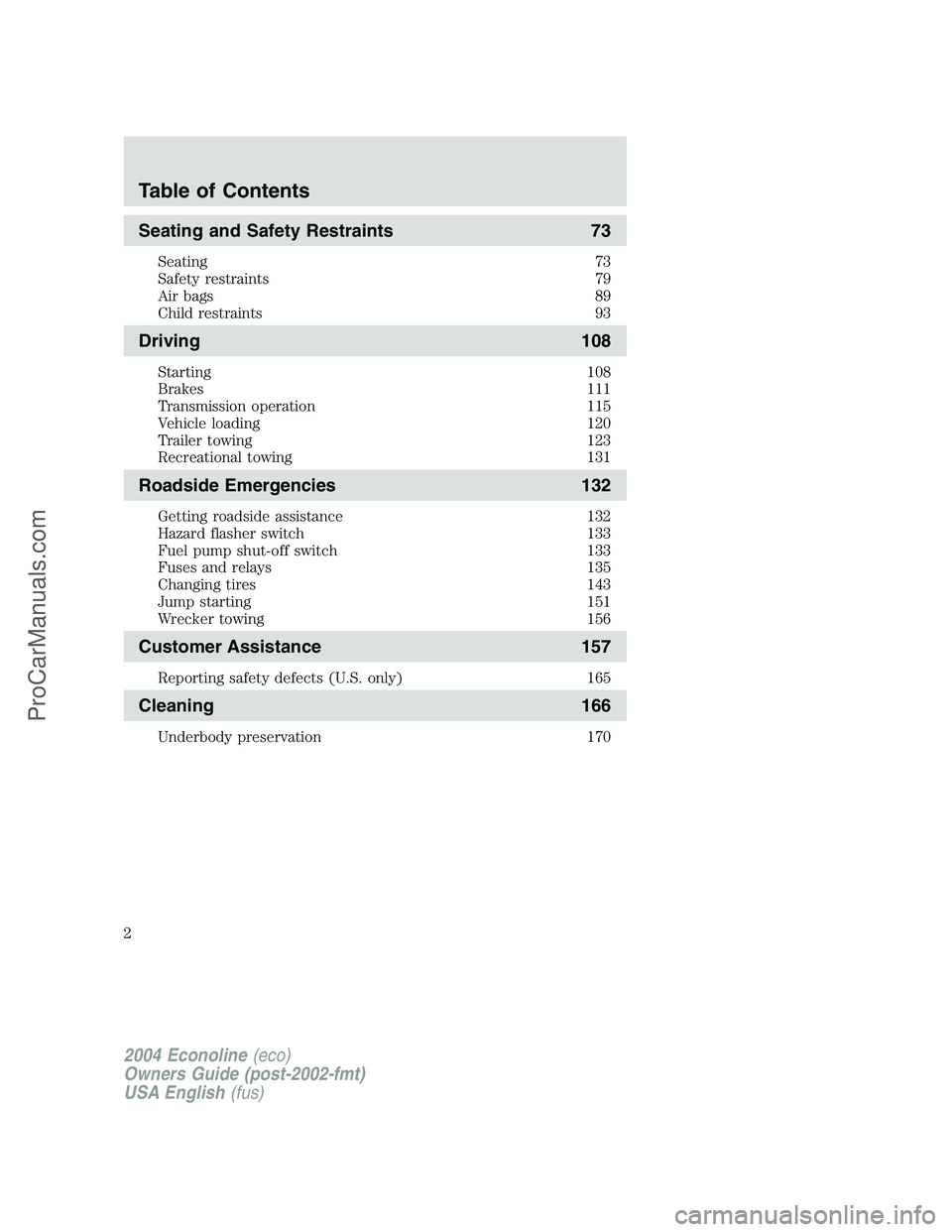
Seating and Safety Restraints 73
Seating 73
Safety restraints 79
Air bags 89
Child restraints 93
Driving 108
Starting 108
Brakes 111
Transmission operation 115
Vehicle loading 120
Trailer towing 123
Recreational towing 131
Roadside Emergencies 132
Getting roadside assistance 132
Hazard flasher switch 133
Fuel pump shut-off switch 133
Fuses and relays 135
Changing tires 143
Jump starting 151
Wrecker towing 156
Customer Assistance 157
Reporting safety defects (U.S. only) 165
Cleaning 166
Underbody preservation 170
2004 Econoline(eco)
Owners Guide (post-2002-fmt)
USA English(fus)
Table of Contents
2
ProCarManuals.com
Page 90 of 240
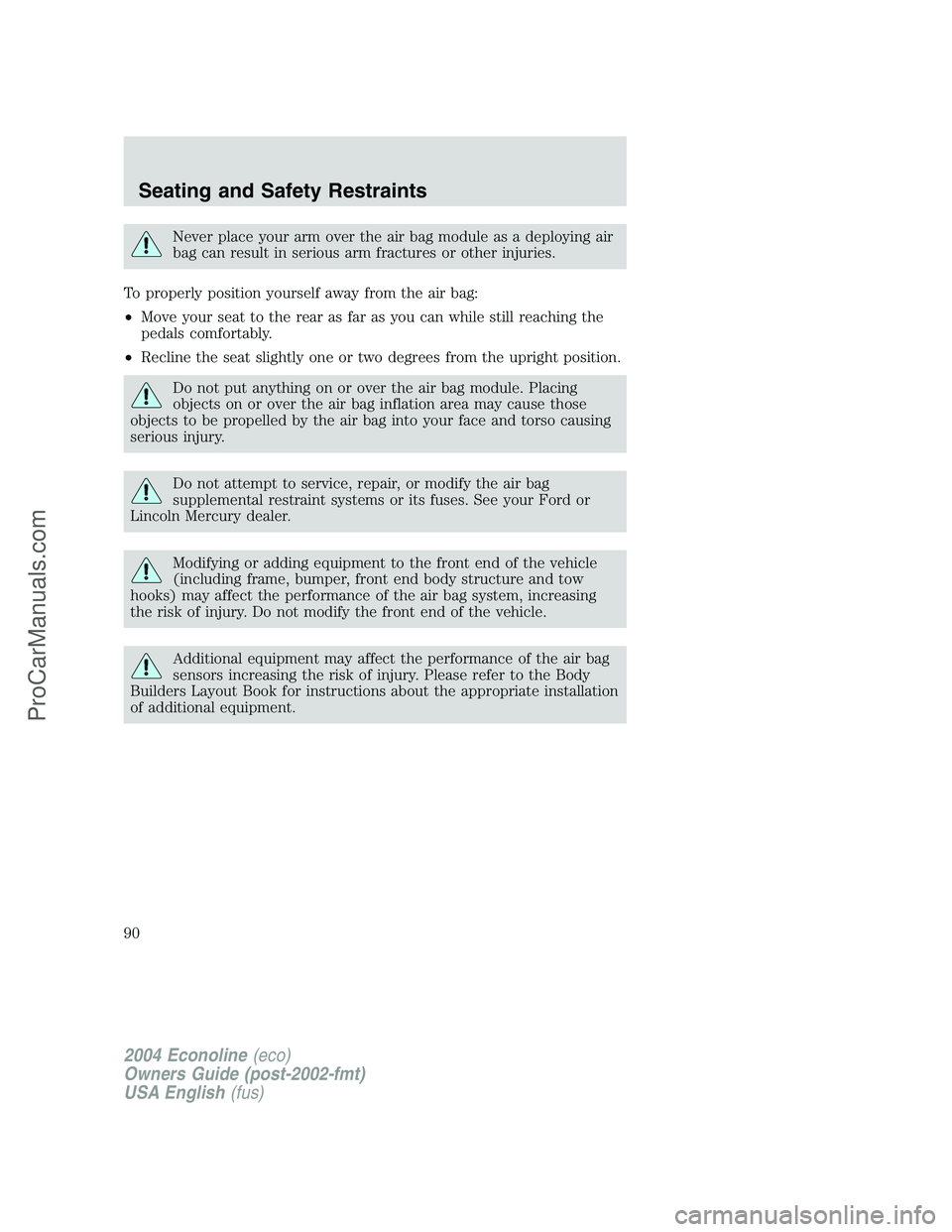
Never place your arm over the air bag module as a deploying air
bag can result in serious arm fractures or other injuries.
To properly position yourself away from the air bag:
•Move your seat to the rear as far as you can while still reaching the
pedals comfortably.
•Recline the seat slightly one or two degrees from the upright position.
Do not put anything on or over the air bag module. Placing
objects on or over the air bag inflation area may cause those
objects to be propelled by the air bag into your face and torso causing
serious injury.
Do not attempt to service, repair, or modify the air bag
supplemental restraint systems or its fuses. See your Ford or
Lincoln Mercury dealer.
Modifying or adding equipment to the front end of the vehicle
(including frame, bumper, front end body structure and tow
hooks) may affect the performance of the air bag system, increasing
the risk of injury. Do not modify the front end of the vehicle.
Additional equipment may affect the performance of the air bag
sensors increasing the risk of injury. Please refer to the Body
Builders Layout Book for instructions about the appropriate installation
of additional equipment.
2004 Econoline(eco)
Owners Guide (post-2002-fmt)
USA English(fus)
Seating and Safety Restraints
90
ProCarManuals.com
Page 115 of 240

AUTOMATIC TRANSMISSION OPERATION
Brake-shift interlock
This vehicle is equipped with a brake-shift interlock feature that prevents
the gearshift lever from being moved from P (Park) when the ignition is
in the ON position unless brake pedal is depressed.
If you cannot move the gearshift lever out of P (Park) with ignition in
the ON position and the brake pedal depressed:
1. Apply the parking brake, turn ignition key to LOCK, then remove the
key.
2. Insert the key and turn it to OFF.Apply the brake pedal and shift
to N (Neutral).
When the key is in the ignition and in the OFF position, the
automatic transmission shift lever can be moved from the P
(Park) position without the brake pedal depressed. To avoid unwanted
vehicle movement, always set the parking brake.
3. Start the vehicle.
If it is necessary to use the above procedure to move the gearshift lever,
it is possible that a fuse has blown or the vehicle’s brakelamps are not
operating properly. Refer toFuses and relaysin theRoadside
emergencieschapter.
Do not drive your vehicle until you verify that the brakelamps
are working.
Always set the parking brake fully and make sure the gearshift is
latched in P (Park). Turn the ignition to the LOCK position and
remove the key whenever you leave your vehicle.
If the parking brake is fully released, but the brake warning lamp
remains illuminated, the brakes may not be working properly.
See your dealer or a qualified service technician.
2004 Econoline(eco)
Owners Guide (post-2002-fmt)
USA English(fus)
Driving
115
ProCarManuals.com
Page 135 of 240
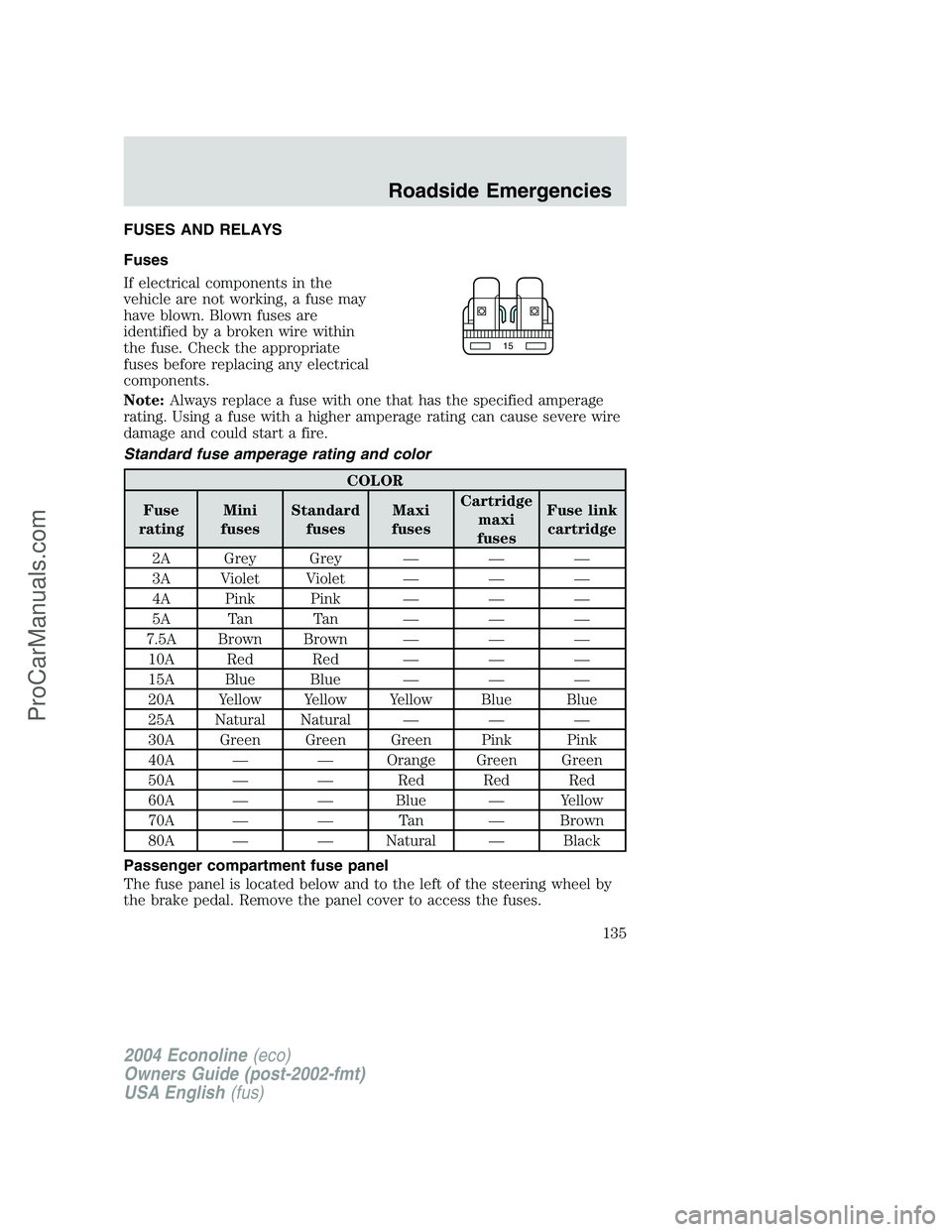
FUSES AND RELAYS
Fuses
If electrical components in the
vehicle are not working, a fuse may
have blown. Blown fuses are
identified by a broken wire within
the fuse. Check the appropriate
fuses before replacing any electrical
components.
Note:Always replace a fuse with one that has the specified amperage
rating. Using a fuse with a higher amperage rating can cause severe wire
damage and could start a fire.
Standard fuse amperage rating and color
COLOR
Fuse
ratingMini
fusesStandard
fusesMaxi
fusesCartridge
maxi
fusesFuse link
cartridge
2A Grey Grey———
3A Violet Violet———
4A Pink Pink———
5A Tan Tan———
7.5A Brown Brown———
10A Red Red———
15A Blue Blue———
20A Yellow Yellow Yellow Blue Blue
25A Natural Natural———
30A Green Green Green Pink Pink
40A——Orange Green Green
50A——Red Red Red
60A——Blue—Yellow
70A——Ta n—Brown
80A——Natural—Black
Passenger compartment fuse panel
The fuse panel is located below and to the left of the steering wheel by
the brake pedal. Remove the panel cover to access the fuses.
15
2004 Econoline(eco)
Owners Guide (post-2002-fmt)
USA English(fus)
Roadside Emergencies
135
ProCarManuals.com
Page 136 of 240

To remove a fuse use the fuse puller tool provided on the fuse panel
cover.
The fuses are coded as follows.
Fuse/RelayLocation Fuse Amp
Rating Passenger Compartment Fuse Panel
Description
1 5A 4–Wheel Anti–lock Brake System (4WABS) module
2 10A Remote Keyless Entry (RKE), O/D cancel, Low vacuum (Diesel engine
only)
3 15A RKE module, Trip computer, Radio, Instrument illumination, Video Cassette
Player (VCP) and video screens,
Overhead console
4 15A Modified vehicle, Courtesy lamps
1234 5
7
68910 1142
43
44
13
12 14
15 16 17
19
18
2021 22 23
25
24
26 27 28 29
31
30 32 33 34 35
37
36 38 39
40
41
2004 Econoline (eco)
Owners Guide (post-2002-fmt)
USA English (fus)
Roadside Emergencies
136
ProCarManuals.com
Page 139 of 240

Power distribution box
The power distribution box is located in the engine compartment. The
power distribution box contains high-current fuses that protect your
vehicle’s main electrical systems from overloads.
Always disconnect the battery before servicing high current
fuses.
Always replace the cover to the power distribution box before
reconnecting the battery or refilling fluid reservoirs
If the battery has been disconnected and reconnected, refer to the
Batterysection of theMaintenance and specificationschapter.
2004 Econoline(eco)
Owners Guide (post-2002-fmt)
USA English(fus)
Roadside Emergencies
139
ProCarManuals.com
Page 140 of 240

The high-current fuses are coded as follows.
Fuse/RelayLocation Fuse Amp
Rating Power Distribution Box
Description
1 — Powertrain Control Module (PCM) diode
2 — Alternative Fuel Control Module (AFCM) diode (Natural gas
vehicle only)
3 10A* Daytime Running Lamps (DRL) module, A/C clutch
4 20A* Natural Gas Vehicle (NGV) tank solenoids (natural gas vehicle
only)
5 15A* Horn relay
6 2A* Brake pressure switch
7 60A** Ignition switch, Fuse panel, Accessory delay
8 40A** Trailer battery charge relay
9 50A** Modified vehicle power
10 30A** Electric brake controller
11 60A** 4-Wheel Anti-lock Brake System (4WABS)
12 60A** I/P fuses 29, 34, 35, 38, 40 and 41
13 20A** Fuel pump relay
14 50A** Auxiliary blower relay
15 30A** Main light switch
16 — Not used
17 50A** Blower motor relay (blower motor)
18 60A** Engine compartment fuses 3, 5, 23 and 26, Instrument panel fuses
26 and 32, Diesel start relay
(Diesel engine only)
19 50A** IDM relay (Diesel engine only)
2004 Econoline (eco)
Owners Guide (post-2002-fmt)
USA English (fus)
Roadside Emergencies
140
ProCarManuals.com
Page 141 of 240
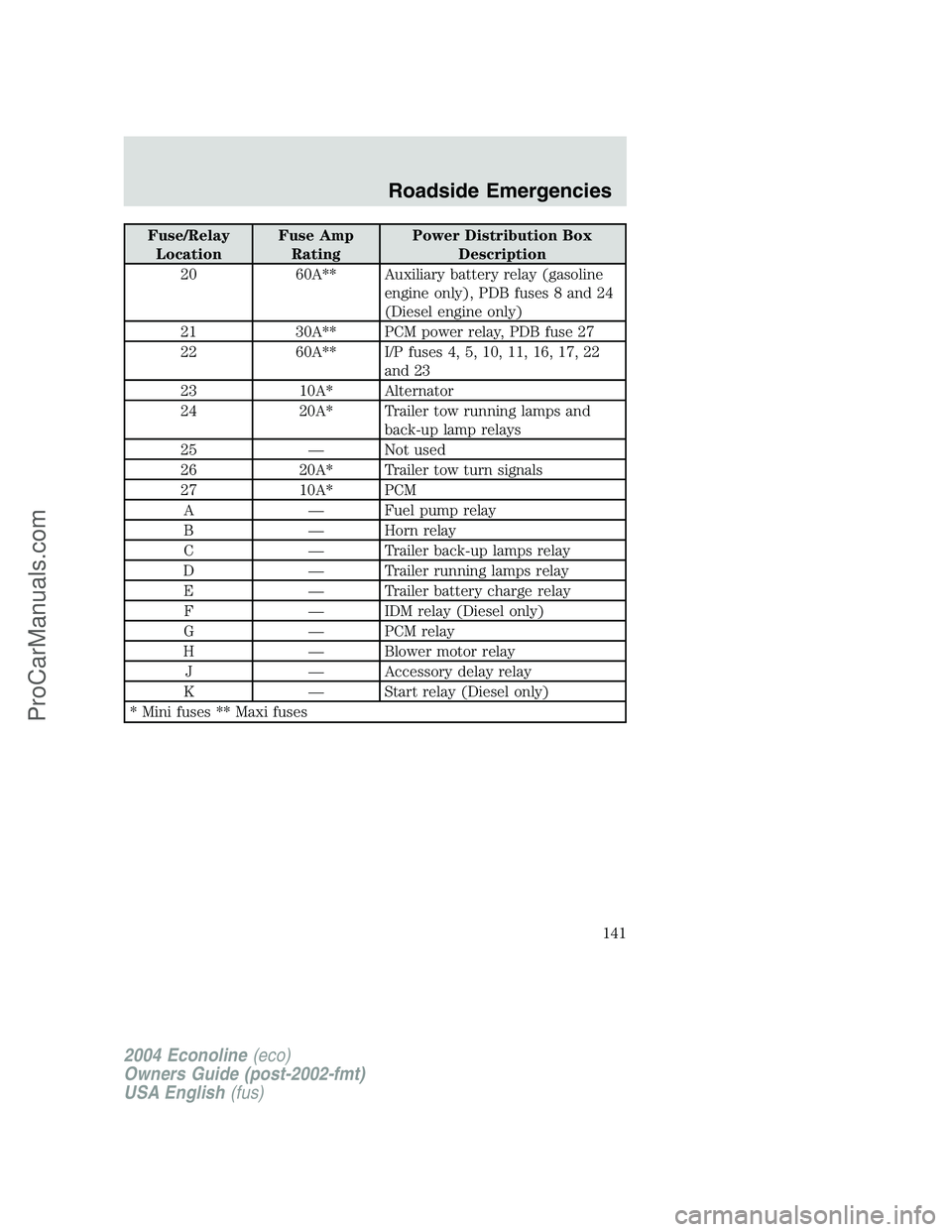
Fuse/Relay
LocationFuse Amp
RatingPower Distribution Box
Description
20 60A** Auxiliary battery relay (gasoline
engine only), PDB fuses 8 and 24
(Diesel engine only)
21 30A** PCM power relay, PDB fuse 27
22 60A** I/P fuses 4, 5, 10, 11, 16, 17, 22
and 23
23 10A* Alternator
24 20A* Trailer tow running lamps and
back-up lamp relays
25—Not used
26 20A* Trailer tow turn signals
27 10A* PCM
A—Fuel pump relay
B—Horn relay
C—Trailer back-up lamps relay
D—Trailer running lamps relay
E—Trailer battery charge relay
F—IDM relay (Diesel only)
G—PCM relay
H—Blower motor relay
J—Accessory delay relay
K—Start relay (Diesel only)
* Mini fuses ** Maxi fuses
2004 Econoline(eco)
Owners Guide (post-2002-fmt)
USA English(fus)
Roadside Emergencies
141
ProCarManuals.com
Page 236 of 240
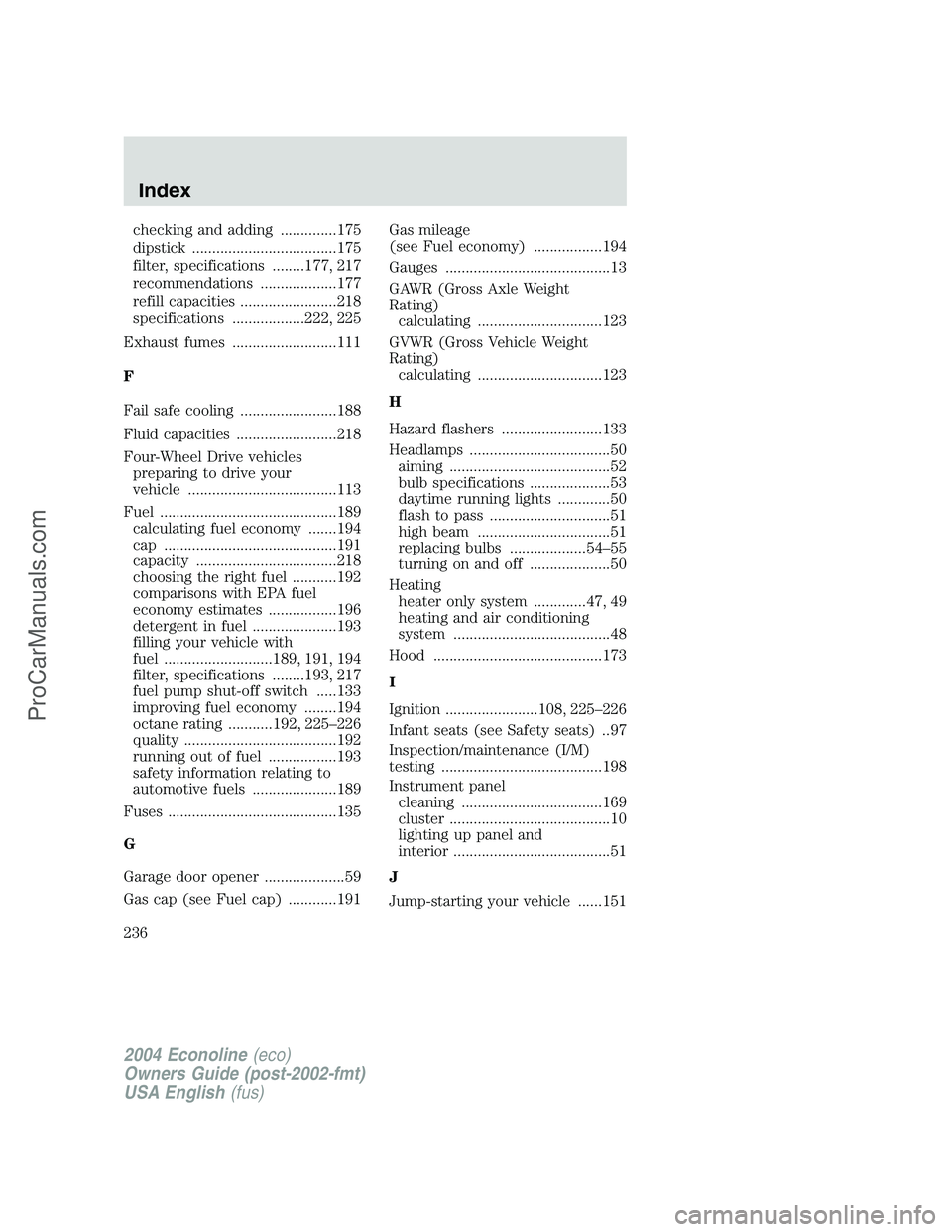
checking and adding ..............175
dipstick ....................................175
filter, specifications ........177, 217
recommendations ...................177
refill capacities ........................218
specifications ..................222, 225
Exhaust fumes ..........................111
F
Fail safe cooling ........................188
Fluid capacities .........................218
Four-Wheel Drive vehicles
preparing to drive your
vehicle .....................................113
Fuel ............................................189
calculating fuel economy .......194
cap ...........................................191
capacity ...................................218
choosing the right fuel ...........192
comparisons with EPA fuel
economy estimates .................196
detergent in fuel .....................193
filling your vehicle with
fuel ...........................189, 191, 194
filter, specifications ........193, 217
fuel pump shut-off switch .....133
improving fuel economy ........194
octane rating ...........192, 225–226
quality ......................................192
running out of fuel .................193
safety information relating to
automotive fuels .....................189
Fuses ..........................................135
G
Garage door opener ....................59
Gas cap (see Fuel cap) ............191Gas mileage
(see Fuel economy) .................194
Gauges .........................................13
GAWR (Gross Axle Weight
Rating)
calculating ...............................123
GVWR (Gross Vehicle Weight
Rating)
calculating ...............................123
H
Hazard flashers .........................133
Headlamps ...................................50
aiming ........................................52
bulb specifications ....................53
daytime running lights .............50
flash to pass ..............................51
high beam .................................51
replacing bulbs ...................54–55
turning on and off ....................50
Heating
heater only system .............47, 49
heating and air conditioning
system .......................................48
Hood ..........................................173
I
Ignition .......................108, 225–226
Infant seats (see Safety seats) ..97
Inspection/maintenance (I/M)
testing ........................................198
Instrument panel
cleaning ...................................169
cluster ........................................10
lighting up panel and
interior .......................................51
J
Jump-starting your vehicle ......151
2004 Econoline(eco)
Owners Guide (post-2002-fmt)
USA English(fus)
Index
236
ProCarManuals.com
Page 237 of 240
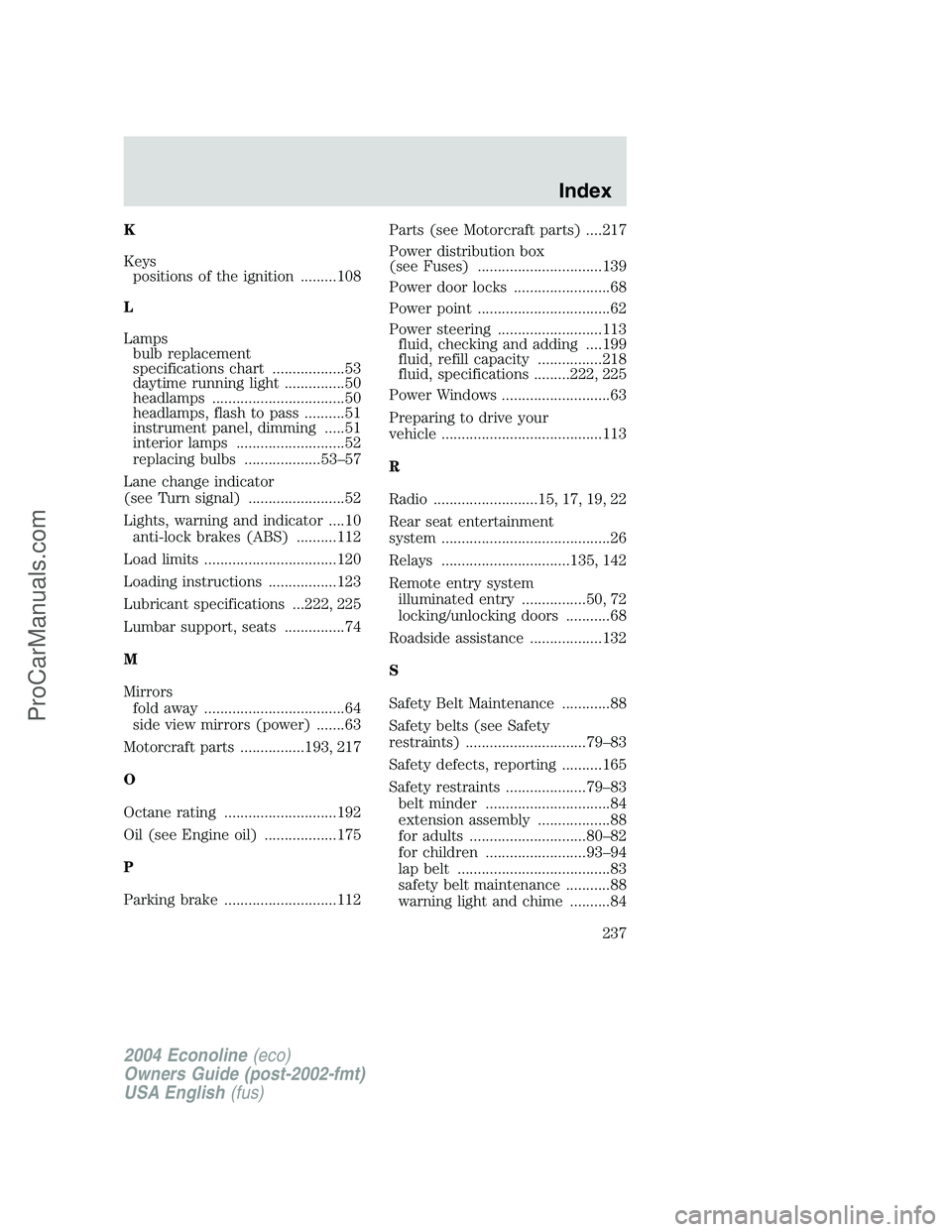
K
Keys
positions of the ignition .........108
L
Lamps
bulb replacement
specifications chart ..................53
daytime running light ...............50
headlamps .................................50
headlamps, flash to pass ..........51
instrument panel, dimming .....51
interior lamps ...........................52
replacing bulbs ...................53–57
Lane change indicator
(see Turn signal) ........................52
Lights, warning and indicator ....10
anti-lock brakes (ABS) ..........112
Load limits .................................120
Loading instructions .................123
Lubricant specifications ...222, 225
Lumbar support, seats ...............74
M
Mirrors
fold away ...................................64
side view mirrors (power) .......63
Motorcraft parts ................193, 217
O
Octane rating ............................192
Oil (see Engine oil) ..................175
P
Parking brake ............................112Parts (see Motorcraft parts) ....217
Power distribution box
(see Fuses) ...............................139
Power door locks ........................68
Power point .................................62
Power steering ..........................113
fluid, checking and adding ....199
fluid, refill capacity ................218
fluid, specifications .........222, 225
Power Windows ...........................63
Preparing to drive your
vehicle ........................................113
R
Radio ..........................15, 17, 19, 22
Rear seat entertainment
system ..........................................26
Relays ................................135, 142
Remote entry system
illuminated entry ................50, 72
locking/unlocking doors ...........68
Roadside assistance ..................132
S
Safety Belt Maintenance ............88
Safety belts (see Safety
restraints) ..............................79–83
Safety defects, reporting ..........165
Safety restraints ....................79–83
belt minder ...............................84
extension assembly ..................88
for adults .............................80–82
for children .........................93–94
lap belt ......................................83
safety belt maintenance ...........88
warning light and chime ..........84
2004 Econoline(eco)
Owners Guide (post-2002-fmt)
USA English(fus)
Index
237
ProCarManuals.com